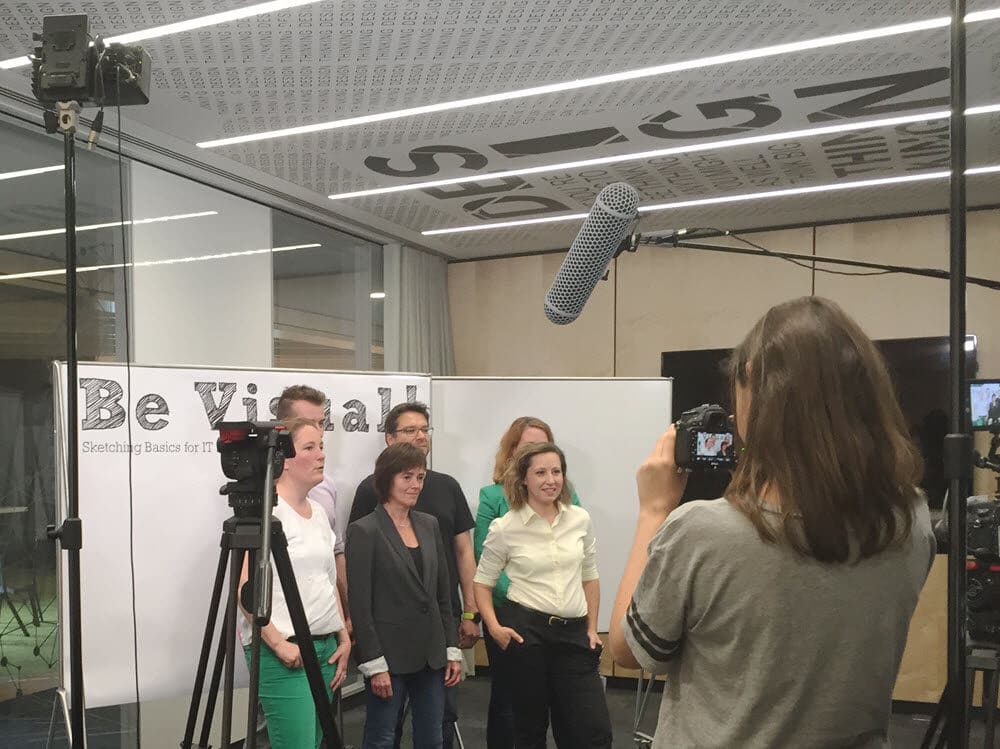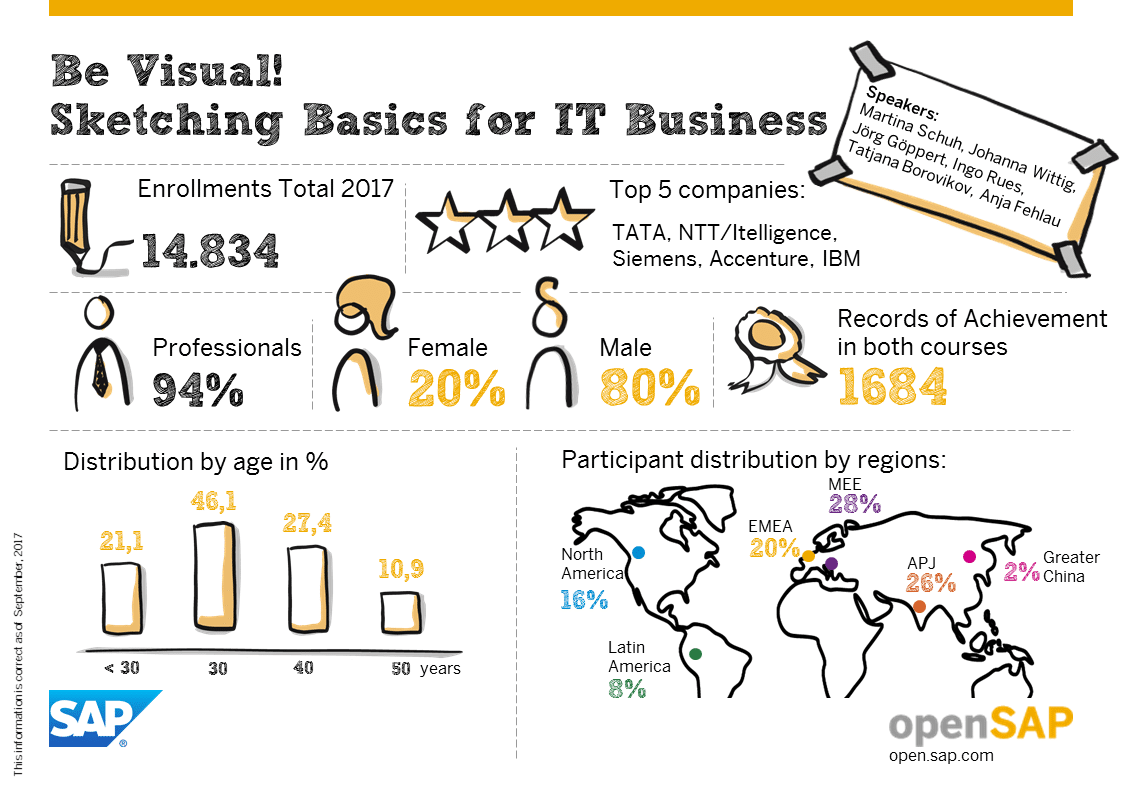openSAP „Be Visual! Sketching Basics for IT Business”: Review and Outlook
Since the year is coming to an end, it’s the right time now to look back at our course “Be Visual! Sketching Basics for IT Business” that successfully ran twice in 2017 on openSAP.
We invited Johanna Wittig, Senior User Experience Designer at SAP and one of the course instructors to give us a glimpse into the idea and the production and delivery of the course.
We will also share facts, figures and feedback with you.
The idea behind the course
openSAP: Why did you create a sketching course for IT developers?
Johanna Wittig: ‘Bring sketching to the developers’ – that was the initial ask where the whole story started. Our manager realized, that agile development approaches require effective exchange between the involved people. Visual communication is known to easily explain a common understanding between discipline. Having this in mind, we started engaging with developers on their collaboration habits when discussing solutions within the team. And what did we find? They use the whiteboard a lot during their discussions, but skills could be improved here, such as the handwriting. That’s why we designed onsite sketching classes focusing on sketching basics for daily use.
openSAP: What did you want to achieve with the course?
Johanna Wittig: Our main goal was to increase developers’ confidence of communicating in a visual way. We especially emphasized that it does not take an artist to visualize ideas. During the first onsite classes, we realized that the content was not only relevant for developers, but for many other roles such as product owners, managers, or scrum masters. Therefore, we started to look for ways to reach a much broader audience, and a MOOC seemed to be the right channel.
openSAP: What challenges did you face when bringing this course to an online and global audience?
Johanna Wittig: First, we had to adapt the course content to meet the online requirements, think of a set of materials, and script our sessions. We had more or less no experience with video recordings. For early prototyping, we used video conference tools to validate if the format of sketching along works, which turned out to be promising. The video team really did a great job in setting the scene for us and our special needs. Overall, we learned a lot throughout the production and are proud of the result.

Course content
Let´s have a look at the course content. Practice is an essential part of the course.
Week 1: Sketching Basics and Writing
In week one, we speak about visual communication basics and tips and tricks for writing. We show you some tips and tricks for sketching in a larger format (flipchart/whiteboard) and walk you through the visual alphabet. Here, the focus is on improving your own handwriting by applying easy tips.
Week 2: Flow Charts and Screen Sketches
The week two topics cover processes, flow charts, and screen sketches. We guide you through a set of important shapes and then practice the combination of text and containers. To introduce the topic of screen sketches we start with some theory, but move to practicing wireframes and teaching you some useful techniques for producing low-fidelity prototypes that can be tested with users.
Week 3: Materials and Objects
The first topic of week three, we cover the use of materials in different sketching scenarios. We talk about pens, markers and their use in given situations; post-its, A4/letter-size paper, and larger formats such as flipcharts and whiteboards. After that we walk you through a collection of objects that can be used for enriching post-its, storyboards, and flipcharts. Here you can practice objects from the area of workspaces, interiors, and buildings, transportation, symbols, and text frames.
Week 4: People and Storyboards
The final weeks’ lessons prepare you perfectly for storyboarding. It starts with people and movement, and ends with the topic of visual storytelling.
We show you how to sketch people with emotions. The focus then shifts to body language, and how to sketch people in different positions. The second topic of the week covers storytelling. Here, we provide a brief overview of the history of storytelling and how stories are designed nowadays. Then we introduce tips and tricks from filmmaking and comics that can be used to create an appealing storyboard. You can learn about reference objects, movement in time and space, and camera distance and perspectives. The use of panels, which structure comics, will also be introduced.
Even by openSAP standards, this course was unusual, because the exercises were done on paper and then submitted as photos or scans.
Participants said that this course really enriches the openSAP portfolio.
Statistics / Key Metrics
This openSAP course ran twice in 2017 with a total of 14,834 course participants.
Please have a look at this graphic to get some more details on the statistics and key metrics.
Participants Feedback
We are very happy to see that the courses were very well perceived by the participants.
We received a lot of feedback with regards to the course content and the MOOC format:
“This is the first time I’ve used openSAP and will be back for more. Particularly liked the exercises and the links to resources.”
“…Open SAP is a good platform to learn new and attractive things from anywhere…”
“Hi, This course has been wonderful and has helped me immensely in writing and drawing sketches. Each and every tip and trick has been outstanding and have found to very useful. …”
“Hi, First of all let me thank SAP and all the tutors for freely allowing people to take these courses and learn on these different subjects. At first I was not prepared for what this course would bring: I thought it would be about the meaning of what we draw, and not about how to draw. It was a good surprise. It was really helpful and these last week was really amazing. Thank you all.”
The course provides content for beginners as well as for advanced sketcher:
“With this course I saw that is possible also for somebody like me, without art skills, to sketch!! In some way now i have dare to try to start sketching !!…”
“First a big thank you for providing this course! Even as an advanced sketcher I learned some interesting things and will use some tips for my future work. “
Also important for us was to see that the participants see a need and use case for sketching in their business lives:
“With sketching, you have opened for me, a new door in the business communication….”
“I enjoy this course a lot. I love drawing and always i make draws to communicate with my team and even with my internal customers. In every change/new request i always use the the greater sentence: a draw is more useful that a thousand words. In more than 90% of the time, a draw and visual communicate are easy to understand for everyone. …”
“I truly enjoyed this class. It was a nice break from my normal SAP studies and has given me new ways to think about, process, and solve customer challenges….”
“I am very happy to take part at this course. It is a big help to use it to viusualise ideas in a fast and interesting way….”
And the participants enjoyed the course:
“…. That shows, that good quality is not expensive and it brings the sense of sharing knowledge in our world. Great team, great presentation :-)”
“…For example, it’s so amusing that you guys demonstrated how to peel a post-it note from the pad. It cracked me up but it proved to be true. Thank you for being so willing to share all the wonderful tips….”
Outlook
We are happy to announce that the course will run again from February 6, 2018 and enrollment is now open.

